There are many deep-sea sediment cores taken from around the world. Measurements of the ratio of different isotopes of oxygen, especially the ratio of 18O to ordinary 16O, give clues about past temperature and about the total global ice mass (and therefore the extent of ice sheets).
The LR04 stack is the result of stacking 57 sediment cores covering the last 5.3 million years, and averaging their data (Lisiecki & Raymo 2005, Paleoceanography, vol. 20, PA1003).
By averaging many sediment cores, the signal becomes more precise, and effects due to the specific location of a single sediment core are smoothed out. Note that in the following graph, time runs from right to left, with the most recent data on the far left. Upper values correspond to less ice mass (generally warmer conditions) while lower values correspond to more ice mass (colder conditions). Click on any of the graphs to get a large, and much clearer, view.
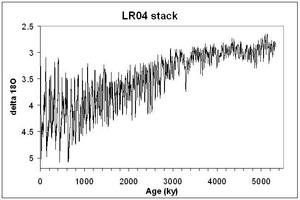
|
| ©Open Mind |
The fast up-and-down variations are advances and retreats of ice sheets. Before about 800,000 years ago, the variations are very fast, showing a basically periodic fluctuation with period about 41,000 years. This is the period of changes in earth's obliquity (the tilt of earth's axis), and the advances/retreats of ice sheets until about 800,000 years ago are due to changes in obliquity. After about 800,000 years ago (the "Mid-Pleistocene Transition"), the changes become larger and take longer, with the dominant cycle being about 100,000 years rather than 41,000.
We can search for any periodic behaviors in the data by doing a Fourier analysis. This gives us a "Fourier spectrum," which is a graph showing the signal strength at each possible frequency of variation.
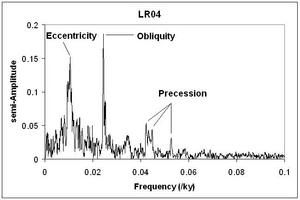
|
| ©Open Mind |
The tallest peak in the Fourier spectrum is at frequency 0.024 cycles/thousand years, corresponding to a period of 41,000 years. This is the obliquity cycle. Then next-tallest peak is at a frequency of about 0.01 cycles/thousand years, a period of 100,000 years. This is often attributed to the cycle of changes in eccentricity of earth's orbit. However, there are several competing theories, so this result is not established. Finally, there are several smaller peaks in the frequency range from 0.04 to 0.06 cycles/thousand years, all of which correspond to frequencies in the cycle of the precession of earth's axis relative to its orbit; these frequencies are certainly due to the cycle of precession.
Fourier analysis tells us what cyclic behaviors are present, but it doesn't tell us about how those cycles may have changed. Perhaps they've gotten stronger or weaker, or disappeared altogether only to reappear. We can investigate this quite effectively with wavelets. Fourier analysis is a frequency analysis; we test a large number of possible frequencies of oscillation, and determine how well each possible cycle frequency matches the data. Wavelet analysis is a time-frequency analysis; we test a lot of frequencies over brief time spans of the data, and slide that "window" throughout time, to see how the quality of fit changes over time.
One way to plot the output is a 3-D time-frequency plot. We plot the quality of the fit as a function of both time (the moment on which our "window" of observation is centered) and frequency (the number of cycles per unit of time). Here's the basic result of a wavelet analysis of the LR04 stack, for time from the present (0) to 5300 thousand years ago, and for frequencies from 0 to 0.1 cycles per thousand years.
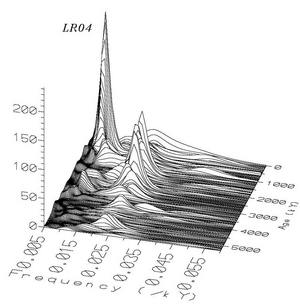
|
| ©Open Mind |
Low frequencies (long periods) are on the left, high frequencies (short periods) on the right, while the present time (0) is at the back, the distant past (5.3 million years ago) is at the front. The height indicates the quality of the fit, high being highly significant while low indicating no significant cyclic behavior at that time and frequency.
The tallest "peak" is at a frequency of about 0.01 cycles/thousand years - that's a period of about 100,000 years. That's near the frequency of the eccentricity cycle of earth's orbit. It's also at a time of between 0 and 1 million years ago. This indicates what is well known, that the 100,000-year cycle of ice ages has only been strong during the last million years (actually, about 800,000 years) or so. The onset of a strong 100,000-year cycle about 800,000 years ago is known as the "mid-Pleistocene transition."
We also see peaks at a frequency of about 0.024 cycles/thousand years (period of about 41,000 years), which rise and fall but persist over almost the entire last 5.3 million years. This is the frequency of the obliquity cycle. From this we deduce what is also well known, that the obliquity cycle has driven the advance and retreat of ice mass for most of the last 5 million years or so. We also see that its strength is highly variable.
It's stronger now than it was in the distant past, and we can see from the original graph (of the LR04 stack) that indeed, the ups and downs of ice mass have gotten consistently stronger over time. We can get a "close-up" of changes in the obliquity cycle by zooming in on a narrower frequency range, from 0.02 to 0.06 cycles/thousand years.
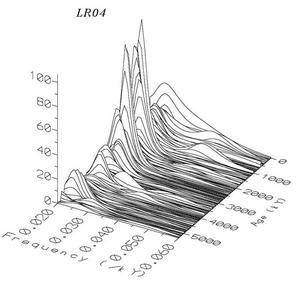
|
| ©Open Mind |
Although the 41000-year cycle is quite persistent, its strength is highly variable. It has generally grown stronger through time, but it also shows sizable ups and downs on shorter time scales.
We can use wavelet analysis to compute the actual size - the amplitude - of the 41,000-year cycle. We can do this for the LR04 stack, and for the changes in obliquity itself. Then we can compare them to see whether or not they change together.
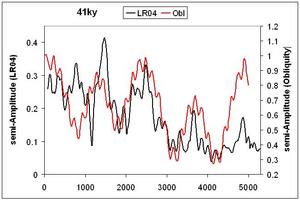
|
| ©Open Mind |
In general, they do tend to change together. When the obliquity cycle gets stronger, so does the response to that cycle in the LR04 stack. This is true on long (million-year) timescales, and on shorter (100,000-year) timescales as well. Most notable is the match between 2 and 3 million years ago; each little rise and fall of the obliquity cycle is matched by a little rise or fall in the 41,000-year cycle of the LR04 stack.
But the match is far from perfect, there's surely more going on in the growth and decay of ice sheets than just the obliquity cycle. The correspondence really breaks down about 1.4 million years ago, which has recently been pointed out by Lisiecki & Raymo (2007, Quaternary Science Reviews, currently in press).
There's yet more from our wavelet analysis. There is cyclic behavior at a frequency of about 0.044 cycles/thousand years (period about 23,000 years); this is the precession cycle. We can get a better view by isolating the frequency range from 0.04 to 0.1 cycles/thousand years.
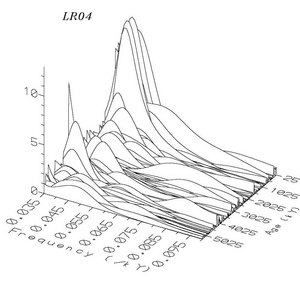
|
| ©Open Mind |
We see that the 23,000-year cycle has also shown a lot of ups and downs in its strength over time, and often becomes so weak that it drops below the "detection threshold" of our wavelet analysis. Just as we did the the 41,000-year cycle, we can use wavelet analysis to estimate the size (amplitude) of this cycle over time, and compare that to the size of the actual precession cycle itself.
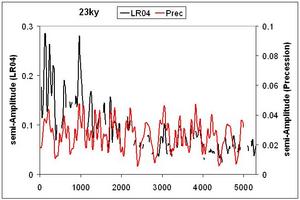
|
| ©Open Mind |
There is some correspondence; lots of the ups and downs of the precession cycle correspond to ups and downs of the 23,000-year cycle in the LR04 stack. But there's also a lot of change in the 23,000-year LR04 cycle that doesn't correspond to changes in the precession cycle.
Unravelling exactly why the obliquity and precession cycles sometimes lead to strong response, and sometimes only to weak response, is one of the as-yet unsolved mysteries of paleoclimate.
There are other unsolved mysteries. Looking back at the first graph, we see that not only have the cycles gotten stronger over time, there's a steady increase in the average ice coverage of the planet.
The reason is as yet unclear, but may be related to a slow decline in the average CO2 concentration in the atmosphere. This much is abundantly clear: the cycles of earth's obliquity and precession are definitely driving the ice ages, or at the very least determine their timing.
Still, there's a lot to learn about ice age cycles; that's one of the things that makes science fun!



Comment: For additional analysis on shorter period cycles of the last 100,000 years and their causes see The Younger Dryas Impact Event and the Cycles of Cosmic Catastrophes - Climate Scientists Awakening.